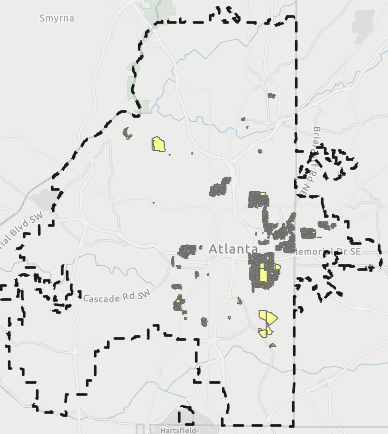Let’s Fix Atlanta’s ADU Setback Rule—It’s Time
- David Melton
- 9 hours ago
- 3 min read
If the City of Atlanta is serious about increasing affordable and diverse housing options, there's one simple zoning change that could unlock a lot of potential: reduce the rear setback for Accessory Dwelling Units (ADUs) in R-4 and R-4A zoning from 15 feet to 4 feet—just like it already is in R-5 zoning.
In the City of Atlanta, ADUs are allowed by right in zones R-4, R-4A, and R-5. R-4 and R-4A (right) make up the vast majority of residential zoning in COA compared to R5 (left). City of Atlanta Official Zoning Map
This might seem like a small technical change, but it is the primary limiting factor we encounter for ADU feasibility, size, and orientation. Even on average lots in the city, it can be the difference in being able to fit an ADU or not. And here’s the real irony: that 15-foot rear setback was likely created in the name of protecting neighbor privacy. But in practice, it can do the opposite. Sure, the ADU ends up farther from the rear neighbor—but it’s now closer to the side neighbors and the primary home. Those side neighbors are the ones who typically have more direct lines of sight into and across a backyard. Meanwhile, rear neighbors often benefit from natural buffers like trees, fences, or just the sheer depth of a backyard. So instead of reducing impact on neighbors, the rule may actually increase it.
The 15' rear setback on this project in Ormewood pushed the ADU into the middle of the yard. Top left, shows the side neighbors primary home is further back than the ADU.
Cities across the country have already figured this out. Los Angeles, Portland, Seattle, Denver, and Minneapolis all allow rear setbacks of 4–5 feet for ADUs in residential zones. These cities understand that lower setbacks allow more homeowners to build ADUs, which increases housing, makes better use of existing infrastructure, and supports walkable communities. And while urban cities average about 4–6 foot rear setbacks for ADUs, suburban areas hover around 10–15 feet. Atlanta has more in common with urban environments so why are we still applying suburban standards to urban lots? Dekalb County, which is predominantly suburban by design, has a smaller rear setback for ADUs than the City of Atlanta at 10 feet.
A variance to reduce the rear setback on this R4 lot was denied. Now the ADU is 11 feet from the primary home. Not everyone is willing to make this concession, which reduces the amount of ADUs built.
This is a really easy and logical fix. And that’s why it shouldn’t be bundled into some years-long ADU overhaul policy (community engagement for this proposal started in 2018). We understand that the city may want to revisit several ADU-related rules in the future—but waiting on an all-inclusive policy reform means missing out on a simple change that could be made right now. Why wait? Let’s not let a big, slow process stall a small, smart solution.
This ADU project in Reynoldstown was zoned R-5. At 4' from the rear property line and 3' from the primary home, it would not have been possible in R-4 or R-4A zoning.
The City of Atlanta should be matching the flexibility of R-5 zoning across R-4 and R-4A areas. Not only would this help more homeowners add backyard units, it would also align with Atlanta’s goals of increasing housing supply, supporting multigenerational living, and promoting neighborhood-scale density. So let’s call it what it is: common sense zoning reform. This small change would make a big difference for everyday Atlantans looking to build housing for aging parents, college-age kids, or long-term renters. City of Atlanta—let’s make this happen.





























Comments